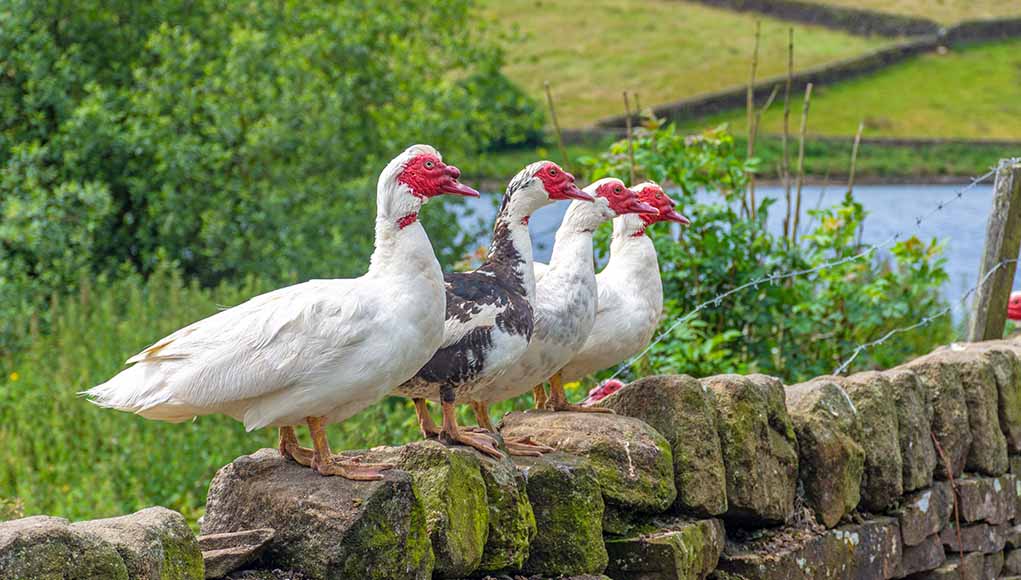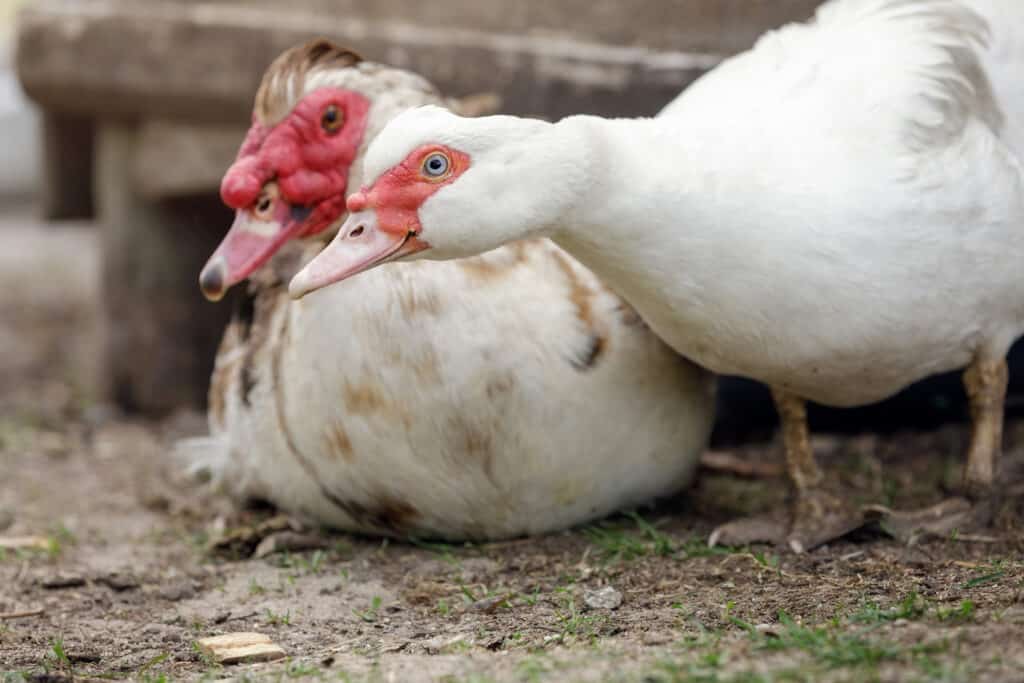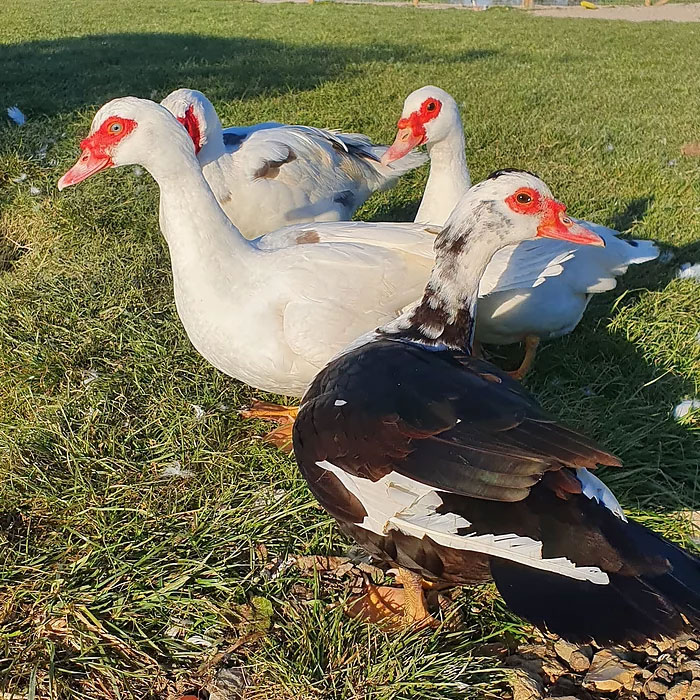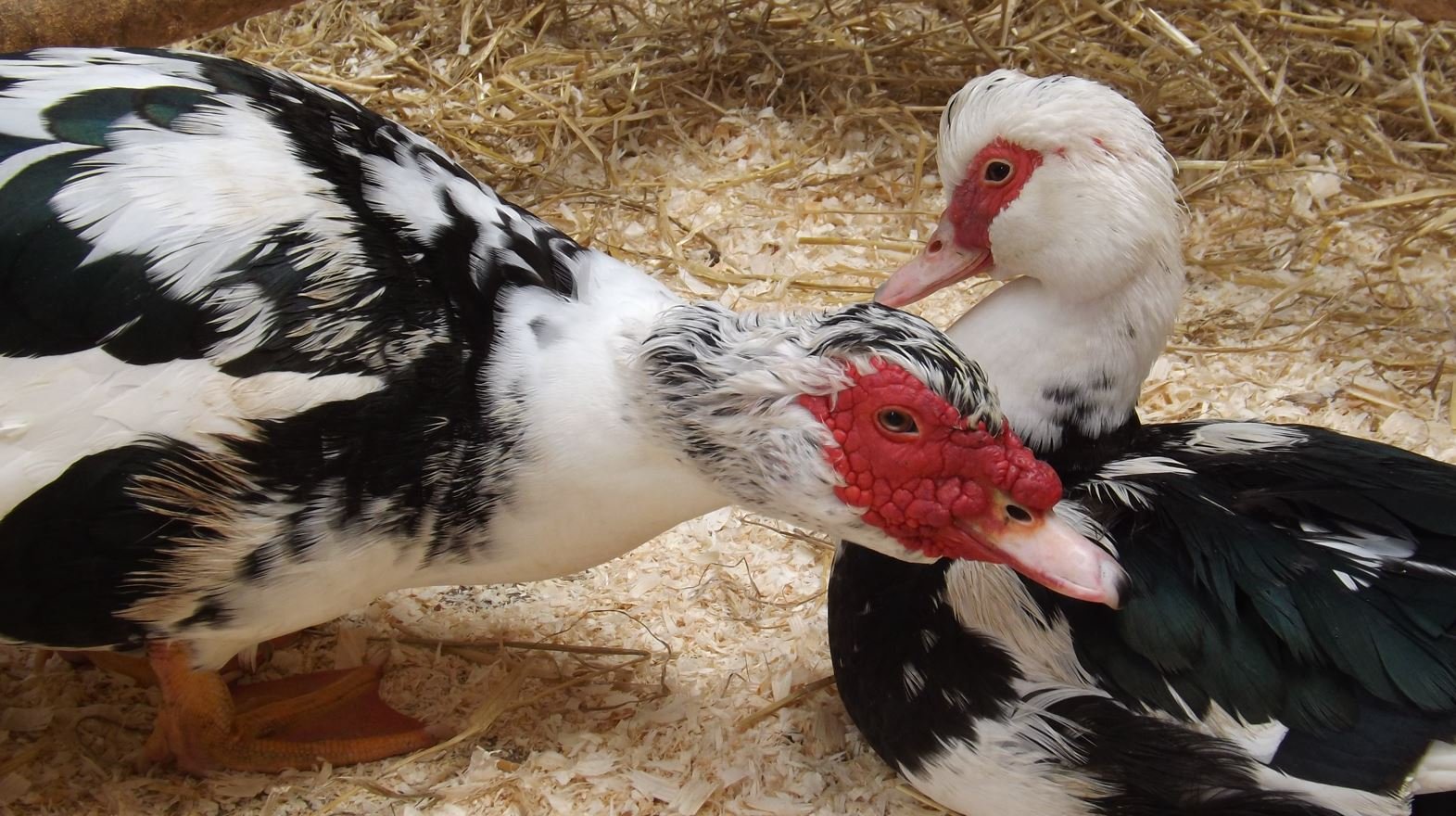Three Incredible Muscovy Duck Facts!
- Muscovy ducks have an average lifespan of eight to twelve years, but in captivity, they can live as long as 20 years.
- These ducks don’t make a lot of noise. Unlike other ducks, they will only make a sound when attacked or overly excited.
- If they get excited or feel threatened, their tails will start to wag persistently. In addition, the males might make a hissing or puffing noise.

Muscovy Duck Scientific Name
Muscovy ducks’ scientific name is Caira moschata, and they belong to the Order Anseriformes, which consists of 180 species of waterfowls. They form part of the Family Anatidae that includes aquatic birds like:
Members of Anatidae are spread over each continent except Antarctica. They are adapted for floating, swimming, and in several cases, diving in shallow water.
There are 174 species in 43 genera within this family. Their common name is the Muscovy duck, but they are also known as the Musky duck or Barbary duck.
Muscovy ducks only have one subspecies called the domestic Muscovy duck ( C.m. domestica).
Size and Appearance
The Muscovy duck is a large bird with a wingspan of up to 64 inches. They are pretty hefty and can weigh up to 15 pounds. However, females are smaller and weigh between 6 to 7 pounds. They have a wide and long body with males measuring around 30 inches and outspread, flat tails.
Because the females are lighter, they are better flyers. Males struggle to get off the ground because of their hefty bodies. So captive females need to have their wings clipped to stop them from escaping.
Muscovy ducks are typically black and white, but there are several variations, including:
- Black
- Blue
- Chocolate
- Green
- White
- Bronze
- Lavender
- Rippled
- Barred
The males’ black feathers change color when the sunlight hits them, but like many bird species, the females are muted and dull. This is because they need to blend into their surroundings while they’re sitting on their nest.
Muscovy ducks’ head is their most distinctive feature with their dark red/ black facial mask and bright red caruncles, which develop quicker in males than females.
In addition, the caruncles are more colorful and cover a larger area on the males. Another distinctive feature of the adult males is the reddish-black knob at the base of their bill.
Both sexes have a crest of erectile feathers on their heads, which they raise when nervous or excited. However, males have more prominent crests, which form part of their mating ritual. Their eyes are brownish-yellow and have a nictitating membrane that helps them see underwater.
Another unique feature is their webbed feet that end in long claws, which allows them to perch in trees. This is why they coined the nickname “greater wood duck.” Lastly, their legs and feet are black in color.

Migration Pattern and Timing
Muscovy ducks do not migrate. However, during droughts, they will move from their inland habitat to swamps and coastal lagoons.
Behavior, Reproduction, and Molting
Muscovy ducks are diurnal birds that do not migrate. But, they are quick and agile animals that roost in trees at night to avoid predators. They spend their days fussing in shallow water and grazing on the ground.
These ducks are social and will often live in pairs and small groups. However, males are territorial, especially when fighting over food and mates, and both sexes can be highly aggressive.
Females do fight each other, but not as often as males. Surprisingly, females will peck at their ducklings if they try to eat from the same food source.
Muscovy ducks communicate by raising and lowering their heads, wagging their tails, and making noises that include quacks and hisses. Males’ calls are low and breathy, while females make a trilling coo.

Diet
These unusual ducks are omnivores, and their preferences include:
Reproduction
Muscovy ducks do not mate for life; they are polygamous, which means that there is one male that mates with several females in their territory. Other animals that practice this mating behavior are:
Muscovy ducks’ mating season occurs between August to May, and females can lay between 8 to 16 white eggs. They build their nests in crevices and hollows and incubate their eggs for 35 days. Females take great care of their eggs and only leave the nest once a day to eat, drink water, and bathe.
Ducklings are born fully developed, but it can sometimes take 24 hours to break through their shells. Their mother teaches them how to feed immediately, and they eat grass, corn, insects, and grains in their first weeks, but anything that crosses their paths is fair game.
The males will often watch over the brood for a few weeks and chaperone them when looking for food, always keeping a watchful eye. Ducklings reach their independence around 60 to 70 days, and females reach sexual maturity at 28 weeks. However, males mature one week later at 29 weeks old.
Lifespan
These ducks live long lives that range between 8 to 12 years in the wild. However, in captivity, muscovy ducks can live for 20 years.
Communication
Unlike most duck species, the Muscovy is silent and only makes noise when excited or threatened. Females make a quiet trilling coo while the males let out a low, calm, breathy call. In addition, if they feel threatened, they make a hissing and puffing sound.
Predators, Threats, and Conservation Status
Muscovy ducks need to watch out for danger where ever they go. In the wild, they make great meals for predators like:
And domestic ducks have to worry about dogs and cats as well.
Population Threats
The biggest threat to Muscovy ducks is habitat loss due to deforestation. Other threats are hunting, egg-collecting, and hybridization with domestic birds.
Muscovy ducks are listed as Least Concern on IUCN’s Redlist and have a population size between 50,000 to 499,999 individuals. However, their number has decreased over the years because of habitat loss.
Muscovy Duck Ecological Niche
Muscovy ducks play a essential role in their ecosystems as predators of terrestrial and water vegetation and animals, making them pivotal in population control. In addition, they are a food source for predators in their habitat.
Domestication
Various Native American tribes in North America had domesticated the Muscovy duck by the time Columbus arrived in the Bahamas. Then, in the 16th century, a few of them were transported to Europe on the ship Santa Maria.
Now, they trade under the name “Barbary duck” and are very popular because their mildly gamey meat is reminiscent of roast beef with the veal’s tenderness.
Their color often determines their taste. For example, white muscovy ducks are sought-after because their meat tastes the best, while darker ducks have more melanin in the skin, which can be unappealing.
Muscovy Ducks as Pets
Muscovy ducks are very calm and peaceful, so they make great pets. However, they need a water source to survive. So if you’re thinking of taking on a Muscovy, you need to provide them with a pond or lake with an abundance of trees surrounding the body of water.
But that’s not all; the trees need to be big enough to have chambers or hollows in the trunk where the ducks can build their nest. Luckily, they also thrive in nesting boxes if the trees aren’t suitable.
They do not like physical interaction with humans and are more than capable of finding their own food. However, you can provide them with mineral supplements and all-purpose vitamins to ensure they are healthy. But, always check with your local veterinarian before giving any supplements to ensure they are safe. Luckily, Muscovy ducks are less susceptible to diseases than other duck species.

Health Issues
Muscovy ducks are generally healthy. However, a study done in Colombia revealed that these ducks do have one health concern. They are more susceptible to Plasmodium and Haemoproteus parasites that both thrive in tropical temperatures. Luckily, these parasites are zoonotic, which means they aren’t harmful to humans.
In addition, they are victims to worms and lice, but that should not be a problem with the proper medications. Another concern is duck plague, which is an acute disease with a high mortality rate. Luckly, there is a vaccine available in the United States.
Feeding
Muscovy ducks are omnivores who eat plants and prey on other animals. Therefore, ducklings need a special diet of all flock feed with added brewer’s yeast. They also enjoy a mixture of grass, corn, and grains. As they mature, juveniles will begin to eat insects, crustaceans, and slugs along with the adults.
All adult Muscovy ducks need is all flock feed, and they will scavenge the rest themselves from the garden and body of water.
If you have a pest problem, Muscovy ducks are an excellent pet to have because they will eat all the flies, slugs, termites, and snails.
But if you want to spoil them, you can give them chopped lettuce, fresh vegetables, pesticide-free grass, and corn.
Setting Up a Coop and Roaming
Muscovy ducks like a high area for roosting,so your coop needs to have sturdy perches. Good companions include chickens, who get on well with these quiet ducks.
If you don’t have perches in your coop, you can add large chicken style nesting boxes, which will work perfectly, but how big should the box be?
The best size nesting boxes for Muscovy ducks would be two feet high and 18 inches wide and deep. If you have two or more of these large ducks, leaving the top of the box open would be beneficial so they can nest together.
You can’t keep muscovy ducks in the coop all the time. They need time to enjoy free ranging and will take this opportunity to chase pests and scavange the area surrounding the water for larvae, crustaceans, and plant roots.
If they are not let out to roam, they will make their discontent known and will thrive if allowed to graze outside the coop.
If letting them roam free is not an option, you can keep them in a run, but they need space where ever they are. At a minimum, they need 15 square feet and some sort of water source.
They often fall victim to dogs, raccoons, foxes and cats, so ensure they are always in a secure area where predators can’t get to them.







Your writing never fails to impress. This post was full of insights and beautifully articulated.